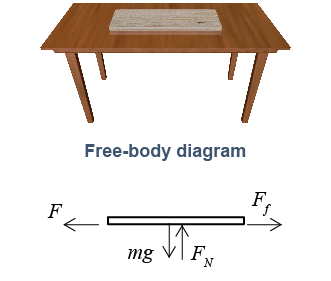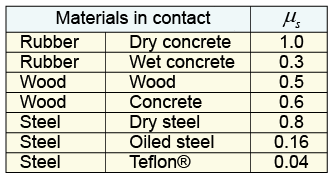|
A board loaded with bricks takes more force to slide than an unloaded board. To account for the difference using a simple model, we assume that the friction force F is proportional to the normal force acting between the sliding surfaces. As an equation, the friction force equals the normal force FN times a constant called the coefficient of friction μ, which depends on the materials of the two surfaces. 
|

|
Static friction occurs when two surfaces could move relative to each other but are not yet moving. The maximum force of static friction is modeled with equation (5.5). 
|
| (5.5) | | | Ff | = | maximum force of static friction (N) | | μs | = | coefficient of static friction | | FN | = | normal force (N) |
| Static friction
|
|
The coefficient of static friction μs is a number generally between 0 and 1. The subscript s in μs identifies the friction as static. 
|
Like other forms of friction, the direction of static friction depends on what other forces are present. The direction of static friction is - parallel to the contact surface and
- opposite to the net of all other forces acting.

| 
|
A 10 N wood board is on a table. How much force does it take to make the board slide if μs = 0.2? | Asked: | friction force Ff | | Given: | μs = 0.2, FN = 10 N | | Relationships: | Ff = μsFN | | Solution: | The board will just slide when F = Ff, so Ff = (0.2)(10 N) = 2 N | 
|
The coefficient of static friction μs predicts the maximum force of static friction. The word maximum is very important because the actual force of static friction is equal and opposite to the net of all other applied forces up to the maximum value. In the example above, the coefficient of static friction for wood sliding on wood is 0.5 and the weight of the board is 10 N. The maximum force of static friction would be 5 N. The actual force of static friction could be anything between 0 and 5 N. If the net applied force is 3 N, static friction creates a resisting force of 3 N. 
|
 The table shows typical values for μs. Coefficients vary greatly with conditions. A rubber tire on wet concrete has less than 1/3 of the friction compared to dry concrete. Real friction forces are highly variable. Numbers in tables are only rough estimates!
The table shows typical values for μs. Coefficients vary greatly with conditions. A rubber tire on wet concrete has less than 1/3 of the friction compared to dry concrete. Real friction forces are highly variable. Numbers in tables are only rough estimates! 
|
William is trying to slide a crate across his room. If the maximum possible force of static friction is greater than the pushing force that William can generate, will the crate begin to slide?
 |
The answer is no. For the crate to start sliding, William must generate a pushing force greater than the maximum force of static friction. If he supplies a force less than the maximum value of static friction, then static friction will equal his pushing force, and the net force on the crate will be zero. 
|

